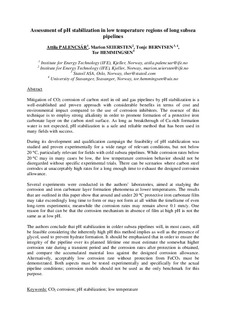| dc.description.abstract | Mitigation of CO2 corrosion of carbon steel in oil and gas pipelines by pH stabilization is a well-established and proven approach with considerable benefits in terms of cost and environmental impact compared to the use of corrosion inhibitors. The essence of this technique is to employ strong alkalinity in order to promote formation of a protective iron carbonate layer on the carbon steel surface. As long as breakthrough Ca-rich formation water is not expected, pH stabilization is a safe and reliable method that has been used in many fields with success. During its development and qualification campaign the feasibility of pH stabilization was studied and proven experimentally for a wide range of relevant conditions, but not below 20 C, particularly relevant for fields with cold subsea pipelines. While corrosion rates below 20 C may in many cases be low, the low temperature corrosion behavior should not be disregarded without specific experimental trials. There can be scenarios where carbon steel corrodes at unacceptably high rates for a long enough time to exhaust the designed corrosion allowance. Several experiments were conducted in the authors’ laboratories, aimed at studying the corrosion and iron carbonate layer formation phenomena at lower temperatures. The results that are outlined in this paper show that around and under 20 C protective iron carbonate film may take exceedingly long time to form or may not form at all within the timeframe of even long-term experiments; meanwhile the corrosion rates may remain above 0.1 mm/y. The authors conclude that pH stabilization in colder subsea pipelines will, in most cases, still be feasible considering the inherently high pH this method implies as well as the presence of glycol, used to prevent hydrate formation. It should be emphasized that in order to ensure the integrity of the pipeline over its planned lifetime one must weigh the accumulated material loss during the transient period of somewhat higher corrosion against the designed corrosion allowance and corrosion rates after protection is obtained; alternatively acceptably low corrosion rate without protection from FeCO3 must be demonstrated. Both aspects must be tested experimentally and specifically for the actual pipeline conditions; corrosion models should not be used as the only benchmark for this purpose. | nb_NO |
